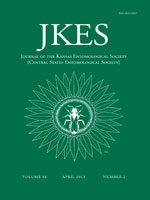Abundances of Neohydatothrips catenatus (Hood) larvae and adults were determined on the native host-plant Pluchea sericea (Nuttall) Coville during 9 April–11 November 2012 at Boulder City in southern Nevada. A total of 531 first instars, 191 second instars, and 53 adults were counted in 800 apical leaf-clusters, and 141 adults were collected in 16 Berlese samples of soil and leaf litter beneath plants. Sex ratios of adults were similar on and beneath plants and were female biased (1 male: 1.8 female). Abundances of N. catenatus were greatest on 10 May 2012, when a maximum 74% of leaf clusters were inhabited by larvae or adults, 13 d after the appearance of new leaf-clusters. Two peaks in abundances of first instars in leaf clusters and adult females beneath and on plants were observed during spring and summer and interpreted as complete generations with thrips developing through all life stages. A third peak in first instars in leaf clusters and adult females beneath plants was observed during late summer and fall and interpreted as an incomplete generation with adult thrips not migrating to leaf clusters. Two additional Berlese samples of soil and leaf litter during January 2013 produced two male and two female adults, suggesting low numbers of N. catenatus adults overwinter beneath plants. Ingestion of chlorophyll by larvae and adults in leaf clusters was evident from the green coloration inside their abdomens. Pluchea sericea appears to support abundant, multivoltine populations of the leaf-feeding N. catenatus.
How to translate text using browser tools
1 April 2013
Phenology of Neohydatothrips catenatus (Thysanoptera: Thripidae) on Pluchea sericea (Asteraceae)
William D. Wiesenborn
ACCESS THE FULL ARTICLE
Chlorophyll
host plants
Insecta
leaf feeding
life cycle
Terebrantia
thrips





